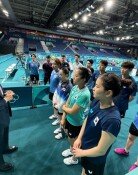Eager to Erase Memories of Defeat, a Strong Japan Sells
Eager to Erase Memories of Defeat, a Strong Japan Sells
Posted August. 17, 2005 06:27,
From Ashes and Ruins to Economic Power-
The United States and Japan, the victor and the vanquished of World War Two, respectively, account for 45 percent of the worlds GDP. Japans GDP is second to the U.S. at $4.6234 trillion as of 2004, while its per capita GNI ranked 9th in the world at $37,180. The countrys foreign exchange holdings are an undisputable first place in the world at $839.3 billion as of late June.
Taking advantage of cash that it reaped in the Korean War, Japan rushed to the era of corporations in the 1950s in which individual companies took the lead in the countrys economic reconstruction. In 1956, just 10 years after its surrender speech, Japan declared at home and abroad in its economic white paper, Japan is no longer in its postwar era.
The distinctive framework of the Japanese economy, including its bureaucracy-lead economic management system, a financing system based on a cozy relationship between corporations and banks, and lifelong employment and a demand for loyalty to a company, were established during that period. Japans experience of economic growth had a large influence on the path followed by its neighboring countries which embarked on economic development later than Japan, including Korea and Taiwan.
In the 1960s when it pursued high economic growth, and the 1970s, when it sought the pleasure of earning money, its history was a burden. Denial of its past history and outside-oriented urges came when the bubble burst for Japan in the early 1990s.
The Young Generations Indifference toward History-
Currently, at least 70 percent of Japanese population is part of the so-called postwar generation who have never experienced war. For these young people in their teens and 20s, war exists only in stories of their parents, not in reality.
Perhaps that is why the concept of the restoration of a great Japan has become good material for commercial cultural products. The Yamato Museum opened in April this year in Hiroshima where atomic bomb was dropped, and is popular. Yamato cookies and Yamato jellies sell like hotcakes in the store of this museum which greeted its 500,000th visitor on August 8. It is easily forgotten that the Yamato was sunk in the East China Sea with some 3,000 Japanese sailors aboard in April 1945.
In movie theaters, a war movie titled Bokoku no Aegis," or "A Lost Country`s Aegis, is attracting young viewers. The movie is about the Self Defense Forces bravery against an imagined enemy conspiracy. Because it became famous through media coverage, Yasukuni Shrine, in which class-A war criminals are honored together with Japanese war dead has been transformed into a place for family picnics for curious Japanese.
About 43 to 46 percent of Japanese in their 30s to 60s said the countrys waging of war was wrong in an opinion poll conducted by the Mainichi Shimbun. By contrast, only 36 percent of 20-something Japanese gave the same answer, which is the lowest figure among age groups. About 34 percent of them answered, I have no idea, while 29 percent said, it was an inevitable war, which are higher figures than in other age groups.
Where Is Japan Headed?-
Diplomatic sources in Tokyo said, Although Prime Minister Junichiro Koizumi is accused of taking the lead in the rightist movement of the country, a look at next-generation politicians in the Liberal Democratic Party (LDP) warrants more worries. Shinzo Abe, the LDPs acting general-secretary, and Shoichi Nakagawa, Minister of Economy, Trade and Industry argue, Japan should no longer be limited by past history, emphasizing a strong Japan and a Japan that can say what it has to say. Their logic is that it is unreasonable to ask todays young generation members who were not even born at that time of the responsibility of the war of the former generation.
They constantly try to rearm the country and secure financing for the armament of the Self Defense Forces (SDF) through revising the peace constitution, saying, Japan should be a normal country just like any other country. The country has decided to introduce a missile defense (MD) system which costs an enormous amount of money, citing potential threats from North Korea and China, and has successfully expanded the scope of SDF overseas. Saying, Whoever becomes the prime minister, he or she must visit Yasukuni Shrine on August 15, they seem to consider war criminals to be forefathers who unfairly lost their lives while serving the country.
The LDP has successfully drafted a revision of the constitution that includes the elevation of the status of the SDF to another level, the allowance of the use of force overseas and the renouncement of the principle of focusing on defense only. This was possible because of the support from those politicians. They continue to drive forward the elevation of the Japanese Defense Agency to a ministry-level position and include a provision on the duty of national defense. Some rightists in the LDP even talk about nuclear armament.
With the Japanese politics moving toward the right, the spirit of the former Prime Minister Tomiichi Murayama discourse of 1995 in which the country reflected on its responsibility of war faded away. The fact that the resolution of the House of Representatives of Japan and the discourse of Prime Minister Junichiro Koizumi commemorating the 60th anniversary of the end of the war regressed from the Murayama discourse symbolizes that Japans perspective of history has regressed over the past 10 years.
Despite worries from neighboring countries, the prevailing analysis is that the next 60 years will be entirely different from the past 60 years for Japan.
Won-Jae Park parkwj@donga.com







